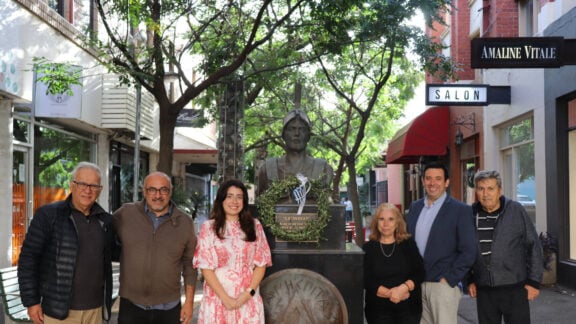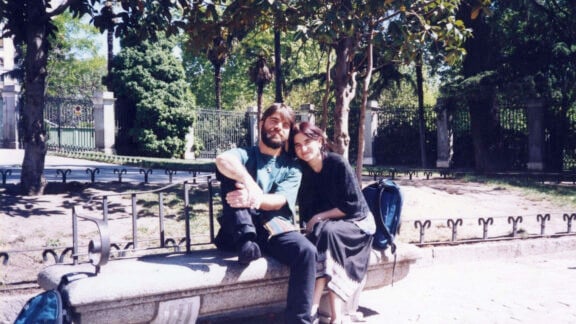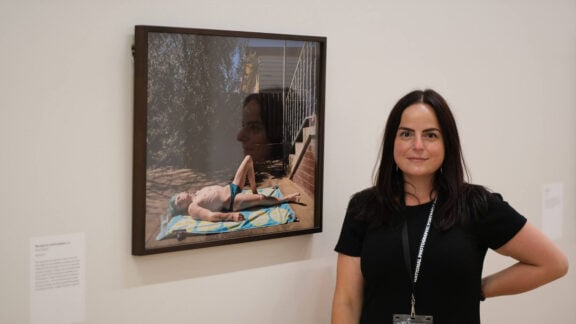Recently, a spate of publications on the relation between cinema and religion reignited a conversation that seemed forgotten after the grand Hollywood biblical epics of the 1950s and early 1960s.
Given the popularity of religion in Greece, it is strange that very few religious films were produced over the last one hundred years and few discussions around them were ever attempted.
We would suggest that religious films are the films whose architectural design presupposes post-historical grand narratives in order to visualise events, from the perspective of their own finality: it is the eschatological aspect of the story and the image, or indeed the eschaton within the story and the image that makes a film religious. It is the perspective that makes a film religious, not the iconographic models employed. Within such a perspective, the camera and its visual fields frame the invisible but ubiquitous presence of the numinous, of the uncanny, and the miraculous, even if they are depicting misery, poverty or misfortune.
In Greek cinema such eschatological or epiphanic presences are missing and indeed the absence of religiosity as a perspective in Greek film history remains an open question for research and discussion. Sometimes religious films are confused with films about Byzantium, as with Yorgos Skalenakis’s Byzantine Rhapsody (1968), or as it happened with the cinema produced during the 1967 dictatorship with the War of Independence in 1821, but these are merely visual appropriations using the period as a backdrop for international stars or nationalistic propaganda.
There are some notable exceptions, which we will discuss here, but usually the setting of the Orthodox Church, Byzantine iconography, the liturgy or its grand aesthetics appear only as the colourful background in many films, when the story is about weddings, funerals or other social events.
There are no religious films in Greece because religious feeling is absent and Christian aesthetics never affected the cultural imaginary in the country. The absence of a spiritual iconography as cultural intervention is part of a wider lack in the expressive forms of culture, with the absence of political discourse in secular or post-secular terms. The spiritual, or the numinous, can only be an anti-language, an anti-aesthetic that could challenge the dominant symbolic order by imagining the visual fields of an anti-order, and of a human condition radically different to the one defined by the specific historical circumstances. That symbolic anti-order can be glimpsed in Costas Sfikas’ Allegory (1986) and Antoinetta Angelidi’s Topos (1985), yet through the fragmented, non-linear and dislocated poetics of experimental cinema.
Most worth-mentioning religious films, in the wider sense of the term, were made during the turbulent late 1980s. Prominent amongst them were Fotos Lambrinos’ Doxobus (1987) and George Stamboulopoulos’ Two Suns in the Sky (1991) two films exploring dissidence and rebellion. The first is a magisterial recreation of a civil war in late Byzantium and at the same time a very significant theological reflection on the active presence of evil in history.
The film was made when the decline of the Greek socialism started creating the populist discourses that were going to dominate Greek political culture from then on since and therefore must be seen as a political parable on the degeneration of popular movements and the gradual transformation of the old revolutionaries, through power, into self-serving opportunists. From the point of Christian religious narrative, therefore, it is a moral tale about the corruptibility of human nature in history, seen as a constant fall without redemption and atonement. The same can be claimed about Stamboulopoulos’ film set in the late fourth century, when the triumphant Christian church was persecuting the remnants of the old religion as found in the theatre. The visual exploration of light, indeed the prismatic exploration of the sunlight, gives this film a particularly expressionistic quality depicting the blinding fanaticism exerted by religion when identified with power.
Probably, the only truly religious film was made by an irreligious nihilist, Theo Angelopoulos. His masterwork Landscape in the Mist (1988) is a unique experiment in the history of Greek and global cinema with religious temporality, the numinous and the sacred. What distinguishes this film is that it is a modern rendering of the medieval fairy tale of Hansel and Gretel, as retold later by the Grimm Brothers. Two lost children are escaping home and are embarking on a journey to find their missing father, who is supposedly a migrant in Germany. Angelopoulos intertwined the old fable with the contemporary nostalgia for the Absolute after the death of God, or the silence of history, as he preferred to call it.
At the end of the film, the remote tree in the Garden of Eden becomes the reminder of the immanent presence of the numinous in everyday life, manifested through madness, fear, blood and constant temptations. Angelopoulos has created an awe-inspiring movie in which the divine epiphany happens through signs and wonders that remain indecipherable and always cryptic: a dying white horse, an evil angel of seduction, the broken hand of God, the winding stairs leading nowhere, abandoned masks, as well as the descent to hell as found in an underground gay disco. Despite his disenchantment and nihilism, Angelopoulos succeeded in visually articulating a negative theology, an apophatic depiction of the traces of numinosity as found in the realm of historical change and existential impermanence. The eyes of the children transform the cruelty of history into a tale of restoration and return to the ground of being. Its filmic space, both oneiric and material, framed an imaginative revelation of the inner conscience of the individual trying to come to terms with the fallen nature of humanity as a historical event. The final scene, with the imaginary tree and the children embracing it, is one of the best symbols ever created by cinematic imagination and has been copied by popular Hollywood films, as in Alex Proyas’ Knowing (2009).
All other Greek films referring to religion dealt with its iconography predominately as decorative motifs, while critics avoid all reference to religious sensibility, as no Orthodox aesthetic has ever been articulated in modern terms, despite the fact that important painters like Konstantinos Parthenis and Fotis Kontoglou tried in their distinct ways to configure a modern visual language for the religious experience.
Traces of a predominantly folk religiosity, or popular piety, can be found in Demos Avdeliodes’ The Tree We Hurt (1986), Demos Theos’ Captain Meintanos: the Image of a Mythical Person (1987), or Lakis Papastathis’ Theophilos (1987). Papastathis is another quasi-religious filmmaker struggling to construct his visual idiom about the presumed authenticity of Greek experience, but always succeeding in misrepresenting his own vision. His film The Only Journey of his Life (2001) was probably the only work that presented the camera through the sublimating eyes of children, trying to understand the chaos of history through awe, nostalgia and wonderment, framing thus certain elements of religious sensibility. But he, like many other directors, confuses folklore with religious sensibility, depriving thus religion of its universality.
It is interesting to point out the time when most of the films appeared, mostly in the 1980s, in a period of immense and profound disenchantment with the project of modernity, together with a throng of pietistic cinematic lives of saints, culminating with the homophobic propaganda Family as the Bastion against AIDS (1987) by Yorgos Hondrokostas.
Greek Orthodoxy remained bound to a folklore demoticism, without any ‘negative potential’ in its aesthetics as an anti-language and anti-community. Allied to power and the state, it was predominantly the central expression of social conformism, unreflexive ritualism and middle-class conventionalism. Unable to articulate alternative visions of sociability and hence of spirituality, it confined itself within the security of the banal and the kitsch, the amorphous and the unilluminated. Whenever Orthodox Christian tradition was employed as anthropological perspective, as in the case of Apostolos Doxiades’ film Terirem (1987), it rendered reality one-dimensional, unable to explore the transparency of the visual revelation and the shadows of the historical experience.
Doxiades, and to a certain degree Stavros Tsiolis (and we don’t have to mention Yannis Smaragdis), are two other interesting cases. Yet all their efforts to depict an Orthodox Christian temporality were mostly transformed into artificial folklore and pseudo-demotic iconographies without any religious connotations.
In a strange way, the perverse, antinomic and chaotic universe of Nikos Nikolaidis’ Singapore Sling (1990) and The Zero Years (2005) reveal more religious fear and trembling in front of the human body, framing new spaces to relocate the numinous. Through his terrifying anthropocentrism, Nikolaidis constructs a religious iconography within the unpredictable universe of desire, which explores the extreme boundaries of human self-destructiveness in terms of a deus absconditus, which could be the father, the hidden god of western metaphysics or indeed the mystified Freudian phallus. Like every atheist, Nikolaidis was in search of origins, not of ends, of beginnings and not of telos, in what seems like a pointless quest that led to the extreme de-formation of the human in his final films. However, hell is an equally spiritual place and Nikolaidis in his final films romanticised the death of all meaningful projects by glorifying the anti-humanism of contemporary capitalism.
Consequently, unlike the anxious ‘spiritual’ struggle we find in the High Catholicism of Robert Bresson, the restless Protestantism of Carl Dreyer, the destructive wretchedness of Paul Schrader, the disturbed incarnational aesthetics of Martin Scorsese or the oneiric landscapes of Andrei Tarkovsky, no religious ‘visual cinematics’ were ever constructed in Greek cinema, not simply because of the absence of any inner struggle but mostly because of the absence of an anthropology about human fallibility and mortality.
Most Orthodox directors have grown up with the doxological understanding of the divine, as an excess and overflow of energy, fecundity and meaning. Consequently they were unable to see human ambiguity and indeterminacy as existential conditions and psychological realities. The struggle of many directors was not simply to find or project religious meaning onto the visual culture of technological modernity but also to find the means to express a religious, and more specifically Christian, understanding of the human phenomenon from within the iconographic patterns of the Greek culture.
As in its other theological manifestations, Orthodoxy never touched upon the fallen nature of the human, the suffering human being. It always interpreted historical experience from the point of the resurrected Jesus, as a post-historical eventuality and not as an active and perishable reality. The interpretation of the historical experience also was framed by the language of the Eucharist and the timeless character of the divine, not by the felicitous inaccuracies of the quotidian language of historicity. It remained, therefore, incapable of dealing with the multi-perspectival world of modernity, and the decentred subjectivities of postmodernity. Finally, the ambivalence and ambiguity of the human phenomenon never found a space of problematisation for the Orthodox Church and its theologians, who ended denying and rejecting all forms of aesthetic innovation and experiment. The language of Christian ‘humility’ and ‘poverty’ never became a visual idiom in the Orthodox cultural imaginary.
In Greek cinema, the cinematic adaptation of Alexandros Papadiamantis’ novel The Murderess by Costas Ferris in 1974 is the only attempt to capture the demonic in history. This unique film, now half-forgotten, remains one of the most powerful religious investigations through images into the determinism of mental iniquity and the vacuum of narcissistic despair, and needs to be revisited. Scholars feel embarrassed to talk about this deeply Christian film, only because of the kitsch and the vulgarity that dominates the Orthodox Church – otherwise it would have been a constant point of reference in discussions about the visual translatability of religious narratives.
On the other hand, for a strange reason, the most interesting religious film, before Angelopoulos’ Landscape in the Mist, was Michael Cacoyannis’ Electra (1962), a film through which the tragic element of classical religion received its most powerful reinterpretation through the Freudian mythology and the existentialist anxiety that dominated post-war Europe. But still as in the case of Angelopoulos, in Electra there was religion but no faith; individual anxiety, therefore romanticism, but no self-conscious mortality. Cacoyannis romanticised the classical story, infusing it with the entanglements of his personal life and the questions of his generation. His framing of religious cinema, a cinema without faith and without transcendence, is what we find as his continuous legacy to Greek cinematography ever after. Filming tragedy, without addressing the tragic as a dimension of being, is like talking about humans without ever mentioning their mortality. His Iphigenia (1977) simply confirmed that an archetypal sacrifice could be transformed into a private tale, about families and their unhappy bedroom adventures.
Bresson advised cinematographers to present “one single mystery of persons and objects” since, as he stated – in probably the most pregnant statement ever made by a film maker – “the true is inimitable and the false untransformable” (1997:83). Greek cinema fought with the evil demon of images and was defeated. Maybe the most religious element in the visual culture of the country is to depict that defeat as the central condition of self-definition in the visual and rhetorical discourses of the culture.
On the other hand, it seems that only atheists and nihilists were imaginative enough to produce religious cinema. Maybe because official religion, by being so obsessively preoccupied with power and wealth, proved to be the greatest opponent of all cultural activity in Greece, intensifying the spiritual and existential vacuum caused by the lack of politics. Yet, the question of religious cinematics must be revisited. Takis Kanellopoulos’ films are full of religious reverence and piety towards the visible creation. His Sky (1962), for example, and Excursion (1966) are the most pious explorations of the realm of material presences from the point of their vulnerability and fragility. The same can be said about the pagan sensuality of Stavros Tornes’ Karkalou (1984) or Gregory Markopoulos’ homoerotic religiosity as the ritual/visual devouring of the male body (if Markopoulos’ cinema was to be included in Greek cinema).
In a sense, religious iconography has always existed in the architectural space of many Greek films, consciously or imperceptibly. Religiosity even less so, despite some striking examples of pure religious sensibility and anthropology. Yet, for critical interpretation, the important question still remains how to imagine a language that could articulate the presence of the spiritual or even account for its absence. In an era of deconstructionist nihilism, cinematographers have to do through disenchantment and cynicism in order to imagine that visual language and construct its conceptual forms.
According to Wassily Kandinsky, the spiritual emerges as “constructional harmonisation of different values” (1994: 193) while maintaining the identity of each individual object as distinct elemental force: the spiritual exists as the “image and likeness” of the real in composition and construction through the visual energy produced by their co-existing differences. Cinematic language follows similar patterns of synthesis, or indeed of anasynthesis, in its search for the numinous. David Bordwell pointed out that Angelopoulos framed “the simultaneous presence of many elements in the visual field soliciting the viewer to search out revealing aspects” (2005: 160). The simultaneous existence of incongruities within their structural harmonisation is what makes the best film by Angelopoulos, Landscape in the Mist, the only religious article of faith produced by visual means in Greek cinema, probably in Greek culture. It is his unique fairytale that transforms history into a landscape of transcendence, ontologically and experientially. So probably by discussing the horizontal dimension in art we can better understand the nature of vertical dimension in history.
* Professor Vrasidas Karalis is head of the Department of Modern Greek and Byzantine Studies at the University of Sydney.








